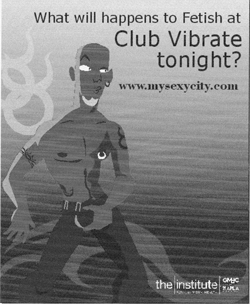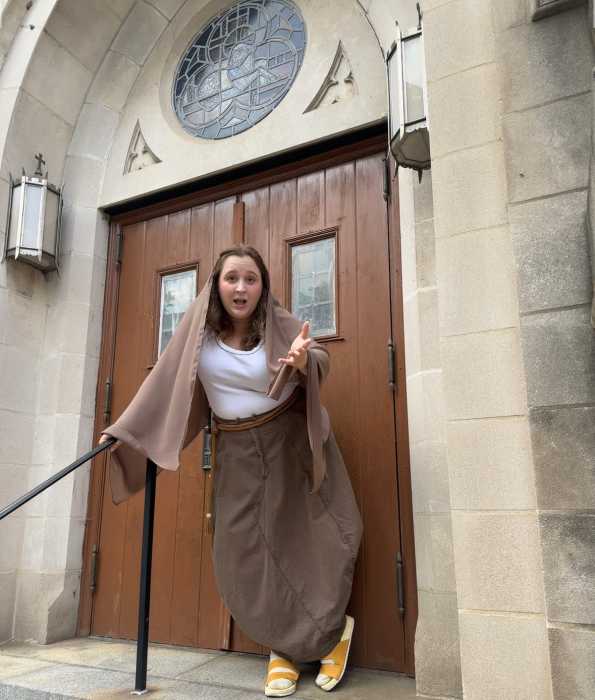GMHC announces new Web-based animation scenarios about sexual choices
As part of their ongoing efforts to reach young gay and bisexual men, particularly in communities of color, with effective HIV prevention messages, the Gay Men’s Health Crisis and AIDS Project Los Angeles on Tuesday launched a new Internet-based tool, mysexycity.com.
The new venture, developed during the past two years by the Institute for Gay Men’s Health, a continuing collaboration between GMHC and APLA, makes use of hip, young animated characters who guide computer users through a variety of interactive and multi-outcome scenarios designed to mirror social choices they face in their own life—about sexual conduct, drug use, and alcohol consumption.
Kioki, a lean young man struggling with the pressures of coming out, Alexis a lean babe with a bra top and a micro dress, and a muscled dude with a big box named Fetish are among the denizens of three venues pictured on the site—Club Vibrate, Christina Street, and the apartments. The scenarios depicted, many of them nightlife-oriented, include frank displays of sexuality—blowjobs in the club’s bathroom for example—that allow the user to explore the consequences of certain choices.
According to Dr. Marjorie Hill, acting executive director of GMHC, the Web venture allows the agency to reach youth at a place that plays a vital and vibrant role in their lives—the Internet—and also allows the group to present HIV prevention messages not as dry statistics and medical details, but rather as real-life situations that everyone faces.
“HIV prevention that’s just abstract and just didactic is not always so effective,” she said at a February 10 press briefing.
George Ayala, a GMHC staffer who heads up the Institute for Gay Men’s Health, elaborated on Hill’s point by explaining that users are empowered by making decisions on behalf of the animated characters in high-risk situations. He explained that all the scenarios are “strength-based,” meaning they are designed to elicit the skills that young people already bring to the table in dealing with personal choices.
“Our role is based is bringing the resources and resiliency of youth to bear,” he said. “The effort is “non-judgmental,” Ayala added, saying that the scenarios hopefully will encourage “consequential thinking” on the part of young men—they will be encouraged to think through to the results that stem from certain choices.
Given the Bush administration’s focus on encouraging sexual abstinence and not promoting sexual behavior, especially same-sex conduct, GMHC and APLA were at pains to emphasize that the cost of samesexcity.com’s development, estimated at several hundred thousand dollars, was privately funded. Still, the precautions posted at the Web site entry portal reflect the increased sensitivity of the current political climate. Users are advised that the site is intended for people 18-25, that neither agency encourages any of the unprotected sexual behavior depicted by some of the choices in different scenarios, and that the use of recreational drugs is not endorsed.
“We are about lowering risk and lowering harm,” Ayala said. “There is no endorsement of specific behaviors here.”
During the development of the Web venture, the Institute made use of focus groups to test the efficacy of the messages and the appeal of the overall presentation, down to the choice of music played. Though the characters speak in cartoon quote bubbles, there is no audio complement to their conversations, since the aim was to make the Web site compatible with the largest universe of computers used around the country.
The site also allows for user feedback which GMHC and APLA hope will form the basis for useful epidemiological data collection.
For now, most of the characters are New Yorkers, with the exception of an L.A. friend that Kioki reaches out to in struggling with his coming out issues. A second installment this summer will incorporate a full range of Angelinos, who hopefully will generate greater interest on the West Coast. Given the strong hold that New York and Los Angeles have on the national gay imagination, the groups expect the Web site to attract users nationwide and they are in active discussions with leading AIDS groups elsewhere to make their communities aware of the project.
Ayala said that money to promote the new Web venture is limited and for now the thrust will be focused on Web banners on sites such as Manhunt.com, ad purchases in what he called “gay rags,” postering in heavily gay neighborhoods, and coasters and date cards in bars and nightclubs. He acknowledged that it remained to be seen how effective these avenues would be in reaching those young men without strong ties to the organized gay community.
“We think this project will have high yield,” Hill said in prognosticating on the success the groups aim to achieve among young gay and bisexual men.
On February 14, Valentine’s Day, GMHC also announced the introduction of a mobile HIV testing van that will travel throughout the city offering rapid tests for the virus. In announcing the new mobile project, the agency noted that an estimated one in four New Yorkers living with HIV are unaware of their serostatus.
gaycitynews.com



































